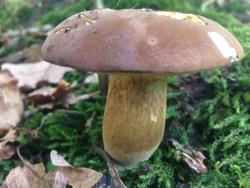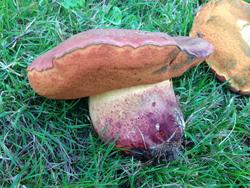30 tháng 7 năm 2015
Bởi Eric Biggane
Cùng với họ nấm dễ nhận diện và phổ biến, họ nấm Boletus là một chi nấm lớn thuộc họ nấm đa họ, gồm các chi nhỏ hơn như Boletus, Leccinum và Suillus. Với việc xác định genom của nấm, họ nấm này đã được chia thành nhiều chi hơn, với tên khoa học thay đổi thường xuyên. Điều này có thể gây hiểu lầm trong quá trình nhận dạng nấm. Tuy nhiên, vì mục đích thu hoạch nấm, mọi nấm có thân và lỗ thay vì màng là các loại nấm Boletus.
Hầu hết các thành viên trong họ lớn Boletaceae có lỗ hoặc ống thay vì màng, giúp chúng dễ dàng nhận diện. Boletales cũng chứa một số loại nấm không có lỗ kiểu ống như Paxillus, Hygrophoropsis và Scleroderma. Nhưng bài viết này tập trung vào các loại nấm Boletus có lỗ kiểu ống thay vì màng hoặc những loại nấm có phần mầm ở bên trong.
Các loại nấm Boletus thường có kích thước lớn, thịt dày và có nhiều màu sắc khác nhau, thân nấm dày hoặc có phần hình cầu và không có vòng trên thân, trừ một số loại của chi Suillus. Thân thường có mạng lưới các đường và điểm đen. Lỗ dưới nắp có thể có màu trắng, kem, vàng, cam hoặc đỏ và thường dễ dàng tách ra khỏi nắp.
Trên toàn cầu, có khoảng 250 loài nấm Boletus, trong đó có khoảng 80 loài được xác định tại Vương quốc Anh. Dựa trên tính độc hại, chỉ có vài loại nấm không ăn được, do đó có nhiều loại nấm ăn được có thể được xác định an toàn để sử dụng.
Đối với người mới bắt đầu thu thập nấm, có ba quy tắc để nhận dạng nấm Boletus ăn được mà sẽ giữ an toàn cho bạn:
-
Hãy chắc chắn bạn có một nấm Boletus, nấm đứng thẳng với thân và lỗ giống như bọt biển thay vì màng dưới nắp và phát triển trong đất, không phải trên gỗ.
-
Nếu có bất kỳ phần nấm nào có màu đỏ, bao gồm thân nấm, lỗ hoặc nắp, hãy tránh vì có thể là dấu hiệu của một loại nấm độc.
-
Thái nấm làm hai phần theo chiều dọc, nếu thịt nhanh chóng chuyển sang màu xanh sáng hoặc ngay lập tức sau khi cắt, hãy tránh vì có khả năng gây độc. Một số loại nấm Boletus ăn được có thể gây mất màu hoặc mốc xanh lục trên lỗ, nhưng chính là thịt nấm thay đổi màu sắc nhanh chóng là dấu hiệu cho thấy nên tránh nấm đó.
Tuân theo những quy tắc trên sẽ giúp bạn an toàn khi thu thập nấm Boletus. Điều này có nghĩa là bạn sẽ bỏ lỡ một số loại nấm ăn được tốt, nhưng quan trọng hơn, bạn tránh các loại nấm độc. Với một chút kinh nghiệm, bạn sẽ dễ dàng nhận biết họ này và có thể nhận diện an toàn một số loại nấm ăn được không tuân theo những quy tắc trên.
Có một loại nấm sẽ đáp ứng các quy tắc trên nhưng tôi không đề xuất ăn; nó không gây độc trong bất kỳ cách nào nhưng sẽ làm hỏng bất kỳ món ăn nào nó được thêm vào: nấm đắng, Tylopilus felleus. Đó là một trong những thứ đắng nhất mà tôi từng thử, vị đắng kéo dài suốt hầu hết cả ngày. Nó trông khá giống với nấm Penny Bun, Boletus edulis, nhưng một chút gặm nhấm nhỏ của nấm sẽ sớm cho bạn biết xem đó có phải là Cep hay nấm đắng hay không. Nếu bạn lo lắng về việc nếm những loại nấm không rõ nguồn gốc, thân của Cep có mạng lưới trắng trên nền hơi tối; thân của nấm đắng có mạng lưới đậm trên nền nhạt.
Cep, Porcini, Penny Bun hoặc King Bolete, Boletus edulis được coi là một trong những loại nấm ăn ngon nhất. Do đó, chúng có nhiều tên và giá cao, nhưng các loại nấm Boletus khác như Bay Bolete, Boletus badius, Dark Bolete, Boletus aereus, hoặc Orange Birch Bolete, Leccinum versipelle cũng rất ngon, chỉ không nổi tiếng bằng.
Trong số các loại Leccinum, thân nấm ít hình cầu hơn, có màu trắng hoặc trắng xám và có đường viền đen bẩn hoặc vẩy đen mờ. Orange Birch Bolete, Leccinum versipelle, là một trong những loại nấm giàu chất dinh dưỡng nhất mọc ở Vương quốc Anh, chứa nhiều protein, carbohydrate và chất béo hơn so với hầu hết các loại nấm khác. Chúng cũng chứa nhiều khoáng chất và vitamin A cùng một số vitamin B. Tất cả các loại Leccinum đều nên được nấu chín trước khi ăn, với thời gian nấu tối thiểu là mười phút.
Suillus chủ yếu có nắp nhớt, một số loại có vòng trên thân và tất cả chúng mọc liên quan đến cây thông. Một trong những loại Suillus phổ biến và dễ nhận diện nhất là Slippery Jack, Suillus luteus, có vòng trên thân và mũ nhầy. Đó là một loại nấm ăn được tương đối tốt sau khi đã làm sạch nhầy, nhưng vị ngon hơn nếu lỗ cũng được làm sạch và nấm bị chặt ra và sấy khô. Một loại Suillus thường gặp khác là Larch Bolete, Suillus grevillei, kỳ lạ ở chỗ khi còn trẻ, nó có một lớp màng lưới trắng hoặc lưới mạng như tơ mạnh phủ lỗ, tương tự như một số loại Cortinarius (họ nấm Webcap). Nên loại bỏ phần trên nhầy và lỗ mềm của nấm Suillus vì chúng có thể gây ra một số rắn hoạt động dạ dày nhẹ ở một số người.
Hầu hết các thành viên trong họ Boletaceae có mối quan hệ sinh thái đối tác với cây và có thể được tìm thấy dưới và xung quanh cả cây lá rộng và cây kim. Tuy nhiên, có một số ngoại lệ như nấm độc Parasitic Bolete, Boletus parasiticus, mọc từ nấm đất thông thường Earth ball, Scleroderma citrinum, điều này làm cho loại nấm Boletus này trở nên độc đáo.
Một số người loại bỏ lỗ khi tìm thấy nấm Boletus và phân tán chúng xung quanh khu vực xung quanh, điều này sẽ để lại một số phấn tử nấm trong môi trường phù hợp để có cơ hội phát triển thành một nấm mới. Tôi cũng làm như vậy với một số loại Boletus tôi tìm thấy vì lỗ có thể trở nên nhầy khi nấu chín. Nhưng nấm như Penny Bun hoặc Dark Bolete quá tốt để bỏ bất kỳ phần nào của chúng đi và tôi sẽ ăn lỗ, thân và thậm chí cả nhện bên trong (từ một lượng nhất định)!
Hầu hết các loại Boletes đều được ưa thích bởi con sâu cũng như chúng ta nhưng tôi đã học cách chia sẻ bằng cách bỏ lại những chiếc nấm bị ăn sâu thực sự và bỏ qua vài con sâu trong những mẫu tốt, chúng được sinh ra trong nấm và chỉ ăn nấm, chúng có vị giống như nấm và tôi không sẵn lòng bỏ qua tất cả các nấm tôi tìm thấy với con sâu vì tôi sẽ sớm đói mà thôi. Điều đó nói, Bay Bolete, Boletus badius, dường như không thu hút quá nhiều con ruồi và thường không có sâu bên trong.
Đã đăng trong Nhận biết Nấm và Cây.
Bài viết trên là một loạt hinh ảnh ghi lại quá trình nhận diện các loại nấm Boletus. Họ Boletus là một trong những họ nấm phổ biến và dễ nhận diện nhất. Nếu bạn muốn tìm hiểu thêm về loại nấm này và cách nhận diện chúng, hãy truy cập trang web của chúng tôi.


